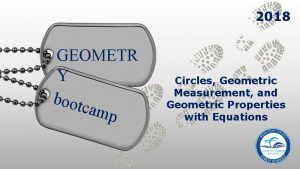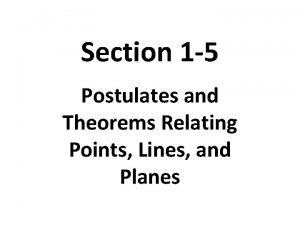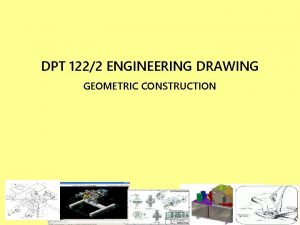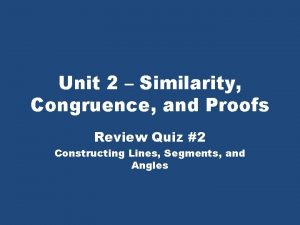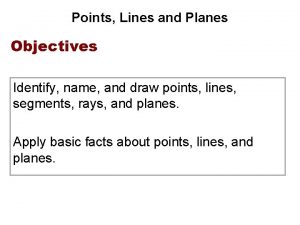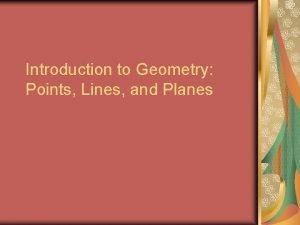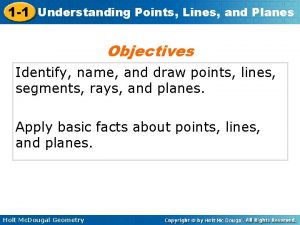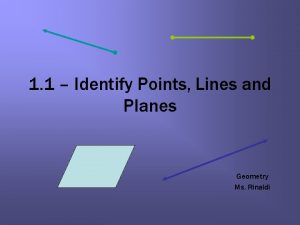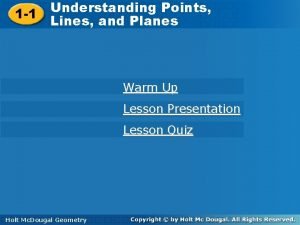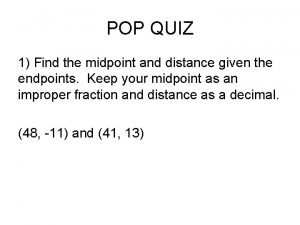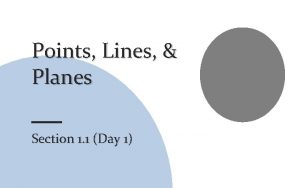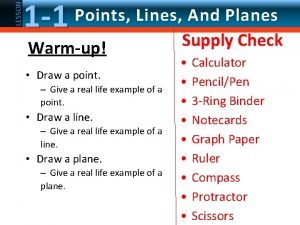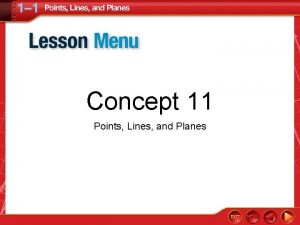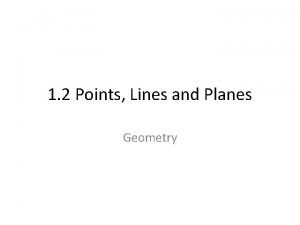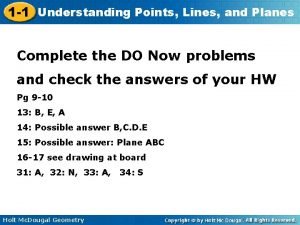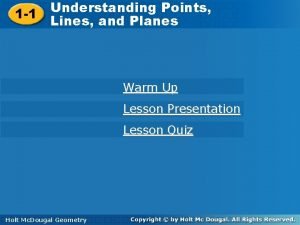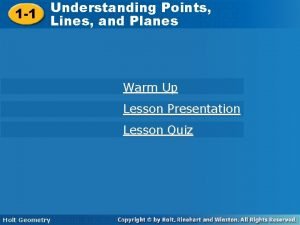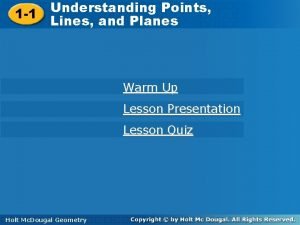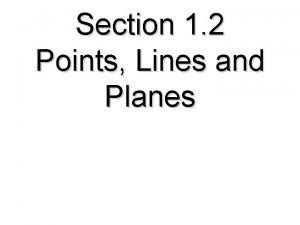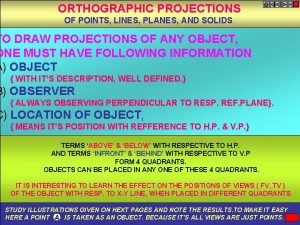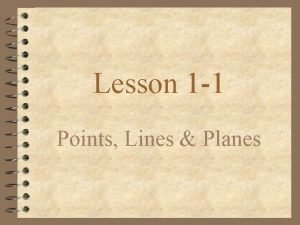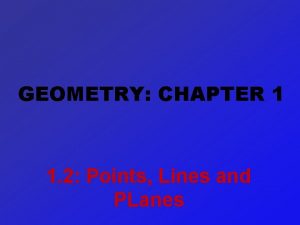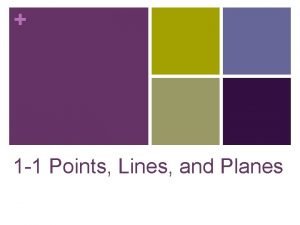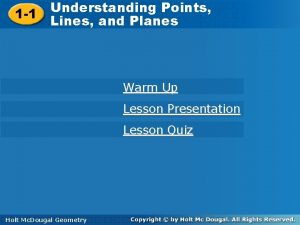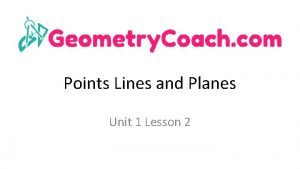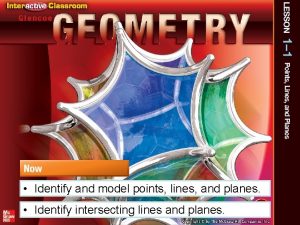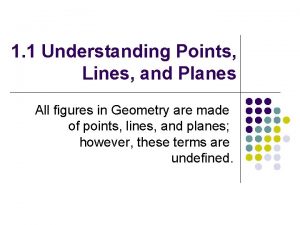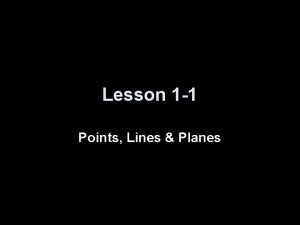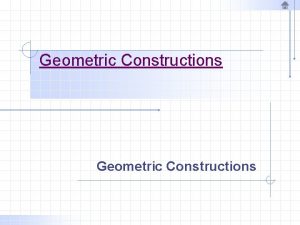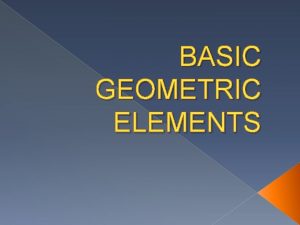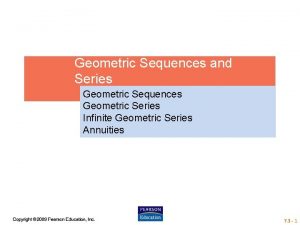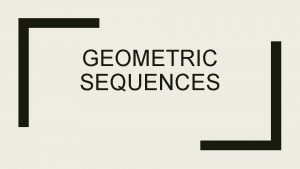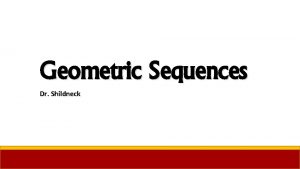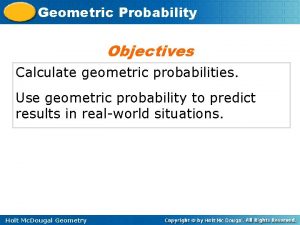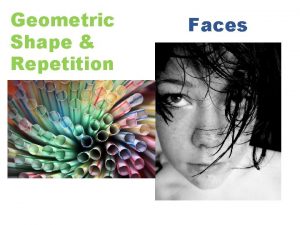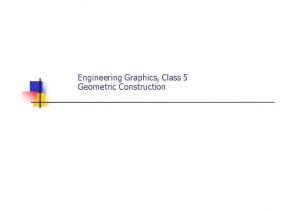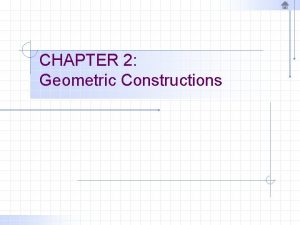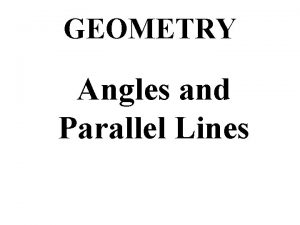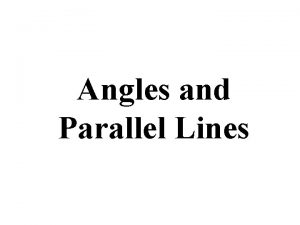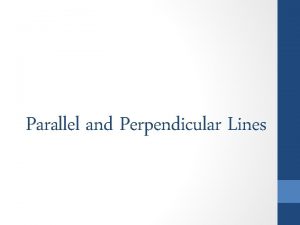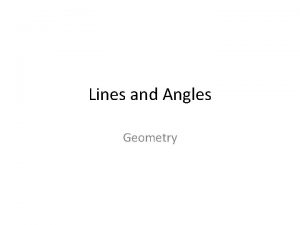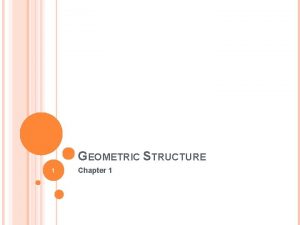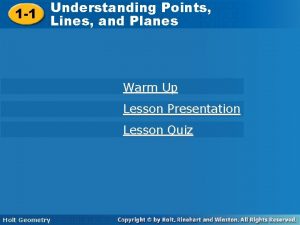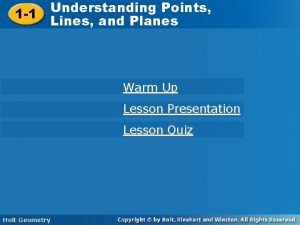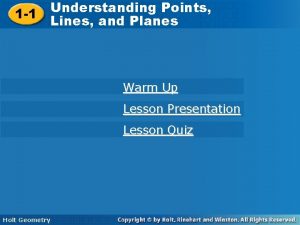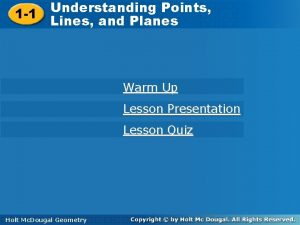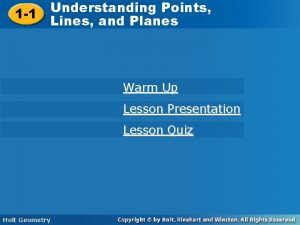Geometric Construction Contents n n Points and Lines



































- Slides: 35

Geometric Construction

Contents n n Points and Lines Cartesian Coordinate System Planes Polygons n n n Angles Circles and Ellipse Geometric Constraints

Geometric Forms n Points n n Points are used to indicate locations in space. Points are considered to have no height, width or depth. A point can be defined as a set of coordinates (x, y) on the Cartesian plane. Lines n n A straight line is the shortest distance between two points. Lines are considered to have length, but no other dimension such as width or thickness. Back to Contents

Cartesian Coordinate System n In order to locate objects in space, the Cartesian Coordinate System is used. This system not only helps to locate objects, but allows for sizes to be made from those locations.

Cartesian Coordinates +Y -X The origin is the place where X, Theand X, Z Y, are andall. Z equal axes are number lines Y, to zero. that are oriented as you see here. Placing the axis in this manner the user can locate points in space -Z +Z +X -Y

Cartesian Points n Absolute Coordinates n n Points that are defined by absolute coordinates refer to the origin for their numeric value. The point is identified by the absolute X and Y distance from zero. Relative or Incremental Coordinates n Points that are defined by relative coordinates reference the previous point on the Cartesian plane. The final point is identified by the distance from the last point referenced.

RRenee Descartes (1596 – 1650) was the French philosopher and mathematician for whom the Cartesian Coordinate System is named. RThe Cartesian Coordinate System made it possible to represent geometric entities by numerical and algebraic expressions RDescartes coordinate system remains the most commonly used coordinate system today for identifying points.

Absolute Coordinates Y 6 D 5 B 4 3 B = X 4, Y 4 C = X 7, Y 1 A 2 C 1 0 A = X 3, Y 2 0 1 2 3 4 5 6 D = X 8, Y 5 7 8 9 X

Relative/Incremental Coordinates Y 6 D 5 B ref A = X 1, Y 2 B 4 C ref B= X 3, Y-3 3 A 2 D ref C= X 1, Y 4 C 1 0 A ref zero= X 3, Y 2 0 1 2 3 4 5 6 7 8 9 X

Lines Y 6 D 5 B 4 3 A 2 C 1 0 Line AD 0 1 2 3 4 5 6 7 Line BC 8 9 X

90° Polar Coordinates Y 180° D 0° 6 5 90° 4 3 270° A 45° similarly toorigin. As To find this. Polar angle. Coordinates we can usework an alternative 0° reference relative in new that the location the pointcoordinates changes, this origin will be placed of a point is based on the last location onlocate the point and the. Use angle can“A” then measured. To point “D”. point as be the reference point. The difference is that you will locate Notice that the angle is measured in a< counter point. The “D” Polar Coordinate is 4. 25 45°. 4. 25 the next point by distance and the angle clockwise direction. is thethe distance, is theon angle the point isplane. located point is 45° located the coordinate in the coordinate plane. 180° 2 1 0 270° 0 1 2 3 4 5 6 7 8 9 X

Right Hand Rule You can use your hand to help orient the coordinate system in a CNC Robotics or CAD application. Make sure you use your right hand! Z Y X Back to Contents

Geometric Forms n Planes are defined by: §Three points not lying in a straight line §Two parallel lines §Two intersecting lines §A point and a line

Origin Planes YY Y Planes in the origin are identified by the axes that lie on the plane. ZZZ XX X The XY Plane. The YZ XZ Plane Back to Contents

Geometric Forms Polygons n n A polygon is any closed plane, geometric figure with three or more sides or angles. Polygons can be inscribed (drawn within a circumference) or circumscribed (drawn around a circumference).

Polygons Inscribed Polygon An inscribed polygon can be constructed by determining the number of sides and the distance across the corners. Circle diameter = distance across corners 8 -sided polygon Example: Connect radial lines where the ends intersect the circumference There are 360 in a circle; for an eight-sided polygon divide 360 by 8 (360 8=45 ) to determine the central angle.

Polygons Circumscribed Polygon A circumscribed polygon can be constructed by determining the number of sides and the distance across the flats. Circle diameter = distance across the flats 8 -sided polygon Example: Connect radial lines by drawing line segments tangent to arc segments There are 360 in a circle; for an eight-sided polygon divide 360 by 8 (360 8=45 ) to determine the central angle.

Polygons Triangle • A triangle is a plane figure bounded by three straight sides. • The sum of the interior angles is always 180°.

Polygons Triangle Equilateral Triangle – All sides equal; all angles equal. Isosceles Triangle – Two sides equal; two angles equal.

Polygons Triangle Right Triangle – Contains one 90 angle. Scalene Triangle – No equal sides or angles.

Polygons Quadrilateral • A quadrilateral is a plane figure bounded by four straight sides. • If the opposite sides are parallel, the quadrilateral is also a parallelogram.

Polygons Quadrilateral Parallelograms: Square – All sides equal, four right angles. Rectangle – Opposite sides are equal, four right angles.

Polygons Quadrilateral Parallelograms: Rhombus – All sides equal; Opposite angles are equal. Rhomboid – Opposite sides are equal; Opposite angles are equal.

Polygons Quadrilateral Trapezoid – Two sides parallel. Trapezium – No sides parallel.

Other Polygons 5 SIDES 6 SIDES 7 SIDES Pentagon Hexagon Heptagon 8 SIDES 9 SIDES 10 SIDES Back to Contents Octagon Nonagon Decagon

Angle Types Acute Angle - Angle that is less than 90°. Complementary Angles Two angles that make up 90°. Obtuse Angle - Angle that is greater than 90°. Right Angle - Angle equal to 90°. Supplementary Angles Two angles that make up 180°.

Bisecting an Angle R Given Angle Strike Arc R any distance. Strike two arcs, shown here as. 625. The arcs can be any size as long as they are equal. Draw a line from where the. 625 arcs intersect to the vertex of the angle. This is the bisector of the angle. The angle is now divided into two equal angles. Back to Contents

Circle Terms Chord is a line that has endpoints at the circumference of a circle The circumference of a circle is the Adistance circle is around a closedthe curve withofallthe outside points along the curve an equal Center point circle. To calculate the circumference: distance from a point Circumference = called Dia. Xthe center. The radius of a circle is half the diameter. The diameter is the longest chord in a circle that passes through the center point of a circle. An arc is a portion of the circumference of a circle.

Ellipse The set of all points in the same plane whose sum of the distances from two fixed points is constant. The sum of the distances of the black lines equals the sum of the distances of the red lines. Back to Contents

Geometric Constraints n When making solid models, constraints are necessary to produce parts of exact shapes and sizes. To make a part parametric it is necessary to use as many geometric constraints as possible. The next set of slides will show what that geometry is.

Geometric Constraints Parallel - Lines that are equal distance from each other at each point along their length. These two lines are parallel. The lines are also representing the symbol for parallel. Perpendicular - Lines that are 90° from one another. These two lines are perpendicular and represent the symbol for perpendicular.

Geometric Constraints Horizontal - A line is horizontal when it is parallel to the horizon. In solid modeling, the line is also parallel in the horizontal projection plane and will appear true length. Vertical - A line is vertical when it is perpendicular to the horizon. This line will be parallel to the front and profile projection planes.

Geometric Constraints Tangent - A line or arc that has one point in common with an arc. If a line is tangent with a circle(Figure A), the line will be perpendicular with a line drawn from the point of tangency through the center point of the arc. If two arcs are tangent (Figure B), a line drawn between the centers will intersect at the point of tangency. Figure A Figure B

Geometric Constraints Concentric - Circles or arcs that share the same center point. These circles and the arcs share the same center point. Coincident - Points that share the same location on the coordinate plane. Points may also be parts of arcs or curves.

Geometric Constraints Collinear - Lines that if projected at each other will become the same line. Collinear lines Coplanar - Two or more objects that sit in the same plane. Fixed Point - A point that has been forced to stay in one location in space. Equal - Two or more lines, arcs, or circles that are given the same magnitude. Back to Contents
 2018 geometry bootcamp answers
2018 geometry bootcamp answers Brand positioning bulls eye
Brand positioning bulls eye Point of difference and point of parity
Point of difference and point of parity Postulates and theorems relating points lines and planes
Postulates and theorems relating points lines and planes Geometric construction engineering drawing
Geometric construction engineering drawing Which geometric construction matches the diagram below?
Which geometric construction matches the diagram below? How many planes are there in the diagram
How many planes are there in the diagram Draw a line in computer graphics
Draw a line in computer graphics Points lines and planes geometry
Points lines and planes geometry Lesson 1 point line and plane
Lesson 1 point line and plane Introduction to computer graphics ppt
Introduction to computer graphics ppt Understanding points lines and planes
Understanding points lines and planes Examples of points lines and planes
Examples of points lines and planes Lesson 1-1 understanding points lines and planes
Lesson 1-1 understanding points lines and planes Quiz 1-2 distance and midpoint
Quiz 1-2 distance and midpoint Worksheet 1-1 points lines and planes day 1
Worksheet 1-1 points lines and planes day 1 Naming points lines and planes
Naming points lines and planes 1-1 points lines and planes
1-1 points lines and planes Points and lines in computer graphics ppt
Points and lines in computer graphics ppt How many planes appear in the figure
How many planes appear in the figure 1-2 points lines and planes answer key geometry
1-2 points lines and planes answer key geometry Understanding points lines and planes
Understanding points lines and planes 1-1 understanding points lines and planes
1-1 understanding points lines and planes 1-1 understanding points lines and planes
1-1 understanding points lines and planes Understanding points lines and planes
Understanding points lines and planes Practice 1-2 points lines and planes
Practice 1-2 points lines and planes Line ab is 75mm long
Line ab is 75mm long A line pq 75mm long
A line pq 75mm long Plane abc
Plane abc Geometry chapter 1 points lines and planes
Geometry chapter 1 points lines and planes Real life examples of skew lines
Real life examples of skew lines Practice a understanding points lines and planes
Practice a understanding points lines and planes Draw and label a figure for each relationship
Draw and label a figure for each relationship Identify points lines and planes
Identify points lines and planes How many planes appear in the figure
How many planes appear in the figure How many planes appear in the figure
How many planes appear in the figure
